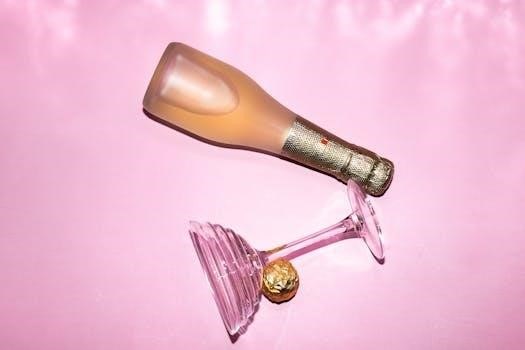The First Years Bottle Warmer Instructions⁚ A Comprehensive Guide
Welcome! This guide provides comprehensive instructions for The First Years bottle warmers, ensuring safe and efficient use. We cover setup, operation, maintenance, and troubleshooting. Follow these steps for perfectly warmed bottles, every time, providing your baby with safe and healthy nourishment.
The First Years bottle warmers offer a convenient and safer alternative to microwaving for heating breast milk, formula, and baby food. These warmers are designed to heat contents evenly and consistently, preserving nutrients that can be lost through rapid heating methods. Unlike microwaves, The First Years warmers minimize the risk of hot spots, ensuring your baby’s meal is at a safe and comfortable temperature.
These devices come in various models, each designed with specific features to cater to different needs. Some models offer digital displays for precise temperature control, while others provide automatic shut-off functions to prevent overheating. The First Years warmers can accommodate most bottle types, including wide-necked, narrow, angled, and even disposable bottles, providing versatility for parents.
Whether you’re a new parent or a seasoned caregiver, understanding how to properly use The First Years bottle warmer is crucial for safe and efficient feeding. This guide offers detailed instructions and tips for making the most of your bottle warmer, ensuring your baby receives perfectly warmed meals with ease.
Understanding Different Models
The First Years offers a range of bottle warmer models, each designed with unique features to suit various needs. Some popular models include the Gentle Warmth Digital Bottle Warmer, known for its precise temperature control and gentle water bath heating, ideal for preserving breast milk nutrients. The Simple Serve Bottle Warmer provides ease of use with its one-button operation, making it perfect for quick feedings.
Another option is the 2-in-1 Simple Serve Bottle Warmer, which combines bottle warming with pacifier sanitization, offering added convenience. The Nursery Bottle Warmer, often paired with a portable cooler, is designed for nighttime feedings, allowing you to keep bottles cool until needed. Each model varies in heating time, capacity, and additional features like automatic shut-off or digital displays.
To choose the right model, consider your specific needs. Do you prioritize precise temperature control, speed, or multi-functionality? Understanding the differences between models will help you select a bottle warmer that best fits your lifestyle and ensures safe and efficient feeding for your baby.
Initial Setup and Preparation
Before using The First Years bottle warmer, proper setup is crucial for safe and efficient operation. Begin by unpacking all components and reviewing the included instruction manual. Place the bottle warmer on a stable, heat-resistant surface, away from water sources and out of reach of children. Ensure the unit is unplugged during setup.
Next, fill the water vial to the recommended level as indicated in the manual; use distilled water to prevent mineral buildup. Pour the measured water into the warming chamber. For models with a cooler, ensure it is properly attached and filled with ice packs if needed. Familiarize yourself with the warmer’s controls and settings, such as power buttons, timers, and temperature adjustments.
Before the first use, run a test cycle with an empty bottle to ensure the unit is functioning correctly. This also helps to eliminate any manufacturing residue. Allow the unit to cool completely before cleaning with a damp cloth. With these initial steps completed, your bottle warmer is now ready to safely and effectively warm your baby’s bottles.
Step-by-Step Usage Instructions
To use The First Years bottle warmer effectively, follow these precise steps. First, ensure the unit is placed on a flat, stable surface and plugged into a functioning outlet. Fill the included vial with the appropriate amount of water based on the bottle size and type of liquid (breast milk or formula), consulting the warmer’s manual for specific measurements.
Pour the measured water into the warming chamber. Place the bottle securely into the warmer, ensuring it sits properly. Select the appropriate warming setting, considering factors like the bottle’s contents and initial temperature. For digital models, use the touchscreen to set the desired warming time. If your model has a timer, set it accordingly; otherwise, monitor the warming process closely.

Once the warming cycle is complete, the unit will typically beep, signaling readiness. Carefully remove the bottle, as it may be hot. Gently swirl the contents to distribute heat evenly. Always test the temperature of the liquid on your wrist before feeding your baby to prevent burns. After use, unplug the warmer and allow it to cool before cleaning.
Water Measurement Guidelines

Accurate water measurement is crucial for achieving the desired bottle temperature and ensuring optimal performance of The First Years bottle warmer. Always refer to the specific model’s instruction manual for precise water level recommendations, as these vary depending on the bottle size, material (plastic, glass, or disposable), and contents (breast milk, formula, or baby food).
Generally, the manual provides a chart indicating the appropriate amount of water to use based on the bottle’s volume in ounces. For smaller bottles (e.g., 4 oz), less water is required than for larger bottles (e.g., 8 oz). Breast milk often requires slightly less water than formula to prevent overheating and preserve its nutritional value. For frozen breast milk, you may need to adjust warming times or water levels.
Use the provided measuring vial or a clean measuring cup to ensure accurate water levels. Avoid overfilling the warming chamber, as this can lead to spills and potential malfunctions. If unsure, start with a slightly lesser amount of water and incrementally increase it until the desired temperature is reached. Always prioritize safety and follow the manufacturer’s guidelines for water measurement.
Heating Times for Different Bottle Types and Sizes
Achieving the ideal bottle temperature hinges on understanding the varying heating times required for different bottle types and sizes when using The First Years bottle warmer. Several factors influence heating time, including the bottle material (plastic, glass, or disposable), the initial temperature of the liquid (refrigerated, room temperature, or frozen), and the volume of the bottle.

Refer to the detailed heating time chart provided in your bottle warmer’s instruction manual. This chart typically outlines recommended heating durations for various bottle sizes (e.g., 4 oz, 6 oz, 8 oz) and liquid types (breast milk, formula). Plastic bottles generally heat faster than glass bottles due to their better heat conductivity. Refrigerated bottles will require longer heating times compared to room-temperature bottles.
Start with the recommended heating time and always test the milk’s temperature before feeding your baby. Gently shake the bottle to distribute heat evenly and dispense a few drops onto your wrist to ensure it’s comfortably warm. If the milk is too cold, continue heating in short increments, retesting after each interval. Avoid overheating, as it can destroy nutrients in breast milk and pose a scalding risk. Always prioritize safety and follow guidelines.
Cleaning and Maintenance
Maintaining your First Years bottle warmer is crucial for its longevity, performance, and hygiene. Regular cleaning prevents mineral buildup, mold growth, and ensures efficient heating. Always unplug the bottle warmer and allow it to cool completely before cleaning.
For routine cleaning, wipe the exterior with a damp cloth and mild soap. The warming chamber should be cleaned regularly to remove milk residue and mineral deposits. Use a soft sponge or cloth with warm, soapy water to clean the interior. Rinse thoroughly with clean water to remove any soap residue. Avoid using abrasive cleaners or scouring pads, as they can damage the surface.

To remove mineral buildup, periodically descale the bottle warmer. Fill the warming chamber with a solution of equal parts white vinegar and water. Let it sit for 30 minutes, then scrub gently with a soft brush. Rinse thoroughly with clean water. Ensure all parts are completely dry before reassembling and using the bottle warmer.
Proper maintenance extends the life of your bottle warmer and guarantees safe, hygienic bottle warming for your baby. Adhere to these cleaning guidelines consistently.
Safety Precautions and Warnings
Prioritize your baby’s safety by adhering to these essential precautions when using The First Years bottle warmer. Always read all instructions before use. Never leave the bottle warmer unattended while in operation. Keep it out of reach of children to prevent burns or other injuries.
Ensure the bottle warmer is placed on a stable, heat-resistant surface. Do not immerse the unit in water or any other liquid, as this can cause electric shock. Always unplug the bottle warmer before cleaning and when not in use. Avoid overheating bottles, as this can destroy nutrients in breast milk and create hot spots that could burn your baby.
Always test the temperature of the milk or formula before feeding your baby. Shake the bottle well to distribute heat evenly. Be cautious when removing the bottle from the warmer, as it may be hot. Never use glass bottles in the bottle warmer unless specifically indicated by the manufacturer.
Inspect the power cord regularly for damage. If the cord is damaged, discontinue use immediately and contact customer support. By following these safety guidelines, you can ensure safe and effective bottle warming for your baby’s health and well-being.
Troubleshooting Common Issues
Encountering problems with The First Years bottle warmer? Here’s a guide to troubleshoot common issues. If the warmer isn’t turning on, ensure it’s properly plugged into a functioning outlet. Check the power cord for any damage. If the unit still doesn’t power on, contact customer support.
If the bottle warmer is not heating, verify that the water level is correct and that the bottle is properly positioned inside the warming chamber. Ensure the correct heating settings are selected for the bottle type and size. If the bottle is still not warming, descale the unit to remove mineral buildup that may impede heating efficiency.
If the bottle is overheating, use less water or reduce the heating time. Always test the temperature of the milk or formula before feeding. Should the bottle warmer beep continuously or display an error code, consult the user manual for specific troubleshooting steps related to the error.
If you notice unusual noises or smells, unplug the warmer immediately and contact customer support. For persistent problems, refer to the FAQs on The First Years website or contact their customer service for further assistance. Regularly cleaning and maintaining your bottle warmer can prevent many of these issues.
Contacting Customer Support
If you’ve exhausted all troubleshooting steps and are still experiencing issues with your First Years bottle warmer, reaching out to customer support is the next best option. The First Years provides several avenues for assistance, ensuring you can find the help you need efficiently.
Start by visiting The First Years website. Here, you can often find a comprehensive FAQ section that addresses common questions and concerns. Look for specific information related to bottle warmers or similar products; The website may also offer downloadable user manuals and troubleshooting guides.
If you can’t find the answer online, you can contact customer support directly via phone. Check the website for the appropriate customer service phone number for your region. When calling, have your model number and purchase date ready. Be prepared to describe the issue you’re experiencing in detail.
Alternatively, you may be able to contact customer support via email. This option is often suitable for non-urgent inquiries. Provide as much detail as possible in your email, including any error messages or specific issues you’ve encountered. Check the First Years website for their official customer service email address. Remember to include your contact information for a prompt response.

No Responses